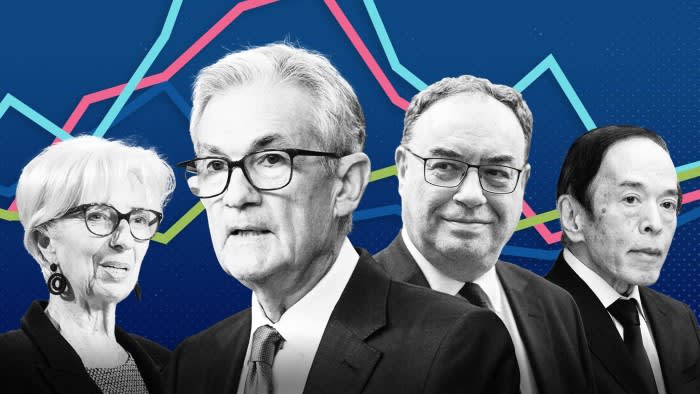Stay informed with free updates
Simply sign up to the Central banks myFT Digest — delivered directly to your inbox.
At the end of the first quarter of 2024, the inflation and interest rate landscape has changed substantially. In early January, financial markets said there was almost an 80 per cent chance that the Federal Reserve would cut US interest rates in the first quarter and that they expected inflation to fall rapidly. Neither of these expectations materialised.
Similar trends were expected in Europe, while the Bank of Japan was expected to keep its interest rate negative. After a momentous quarter in central banking, the world instead looks rather different. Six charts explain what has happened.
Stickier inflation
After a wonderful period of improved inflation performance in the second half of 2023, things have got messier in 2024, especially in the US. There has been only a 0.2 percentage point reduction in US 12-month core inflation in the first quarter so far, compared with 0.7 percentage points in the two previous quarters. European reduction in inflation has also been weaker so far this year.
When we look at more recent comparisons of the same data on a six-month or a three-month basis, US core prices have been rising faster on an annualised basis, signalling a possible resurgence in inflationary pressure.
Fed chair Jay Powell thinks this is just the “sometimes bumpy path” of disinflation and these trends can be caused by blips in the data or seasonal adjustment glitches, but they have raised doubts about the success of disinflation.
Financial markets take fright
Stickier inflation has led financial markets to expect fewer interest rate cuts in 2024 than at the start of the year. The market implied that the December 2024 interest rate in the US, eurozone and UK is roughly 0.75 percentage points higher at the end of March than at the end of December.
That still means markets expect three quarter-point US cuts this year, down from six, and for the moves to be mirrored at the European Central Bank and Bank of England. Financial markets now think that interest rates will stay a bit higher for longer well into 2025, with rates expected to be about 0.6 percentage points higher at the end of next year than thought at the start of this year.
One of the most interesting features of forward interest rate movements has been the lack of any substantial market differentiation between US, eurozone and UK markets.
Financial markets have changed their minds about European interest rates primarily based on poor US consumer price data and good US jobs data. That, of course, makes little sense unless you think European central bankers will act like sheep following their US big brother.
Officials hold firm
While financial markets have substantially revised their views of the future, central bankers have not. Their inflation forecasts for the final quarter of the next three years have moved less than 0.2 percentage points on average in the case of the Fed, BoJ and ECB. The figures are well down on previous quarters, especially in 2022 when energy prices were highly volatile.
The figures suggest that central bankers felt that nothing substantial had changed — the polar opposite of financial markets. In the US and Europe, they were still on course to cut rates, but did not get hugely enthusiastic around New Year and then reverted to a more sober analysis as 2024 progressed.
The BoE is worth singling out in the chart. It persistently changes its inflation forecasts more than other central banks. There are two reasons for this. First, volatile UK gas and electricity prices is something the BoE can do nothing about. The second reason stems from the BoE’s practice of using its inflation forecast to give very imprecise indications of its happiness with forward interest rate curves.
As I have said before, these serve to make the BoE’s forecasting performance appear poor, do not help communication of its reaction function and undermine the central bank’s legitimacy. It is a madness I expect the Ben Bernanke review will address later this month.
Optimism creeping in
A more detailed examination of forecast changes between the final quarter of 2023 and the quarter just ended shows glimmers of optimism creeping into central banks forecasts.
This is clearest in the US, where the Fed has raised its cumulative growth forecast to the end of 2026 by 1 percentage point and a more dynamic US economy has produced only the most modest uptick in the Fed’s inflation forecast and estimate of the appropriate interest rate by the end of 2026. These forecast changes suggest the Fed now believes a persistent supply side improvement is happening — mostly from improved labour force participation.
Not to be outdone, the ECB has also shown a supply side improvement in its latest detailed quarterly forecasts. It thinks the same growth is possible by the end of 2026 from here with lower inflation and interest rates. This is caused mostly by lower imported energy costs.
The BoE’s forecast changes are harder to read, but also suggest some supply side improvements with faster growth and lower interest rates dominating, but also causing a little extra inflation. (Beneath the communication mess, the signal here is that with somewhat fewer rate cuts, the UK can also have higher non-inflationary growth than previously expected.)
A dovish hike
The BoJ ended negative interest rates in March and raised them to a range between 0 and 0.1 per cent. But it did this while stressing “accommodative financial conditions will be maintained for the time being” and indicating the continuation of substantial purchases of Japanese government bonds.
This was not the decisive move towards a normalisation of monetary policy that was expected last autumn and the yen moved down significantly after the announcement leaked in the Japanese press a few days before its March 19 meeting.
Spotting the global monetary policy turning point
Across the world, there is now a clear trend towards easing monetary policy. Switzerland and Mexico began cutting interest rates in March with monetary tightening happening only in Turkey and Japan, countries that have definitively unusual economic trends.
Although rate cuts have mostly come in emerging economies, the ECB and Fed are expected to move in the second quarter. If Andrew Bailey again wants to boast that the BoE was ahead of the pack, I would not rule out a BoE cut in May. This would be a repeat of December 2021. Cuts will be the thing to look out for in the second quarter. Expect another momentous quarter ahead.
What I’ve been reading and watching
A chart that matters
My colleagues Claire Jones, Delphine Strauss and Eva Xiao have written about dodgy data, something that strikes fear into all central bankers because they have to take decisions based on information that might be nonsense. The charts below show US non-farm payroll revisions with an average monthly revision since January 2023 so far of -19,300, 7 per cent lower than the original published figures.
Also Read More: World News | Entertainment News | Celebrity News













